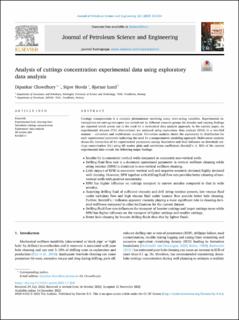| dc.contributor.author | Chowdhury, Dipankar | |
| dc.contributor.author | Hovda, Sigve | |
| dc.contributor.author | Lund, Bjørnar | |
| dc.date.accessioned | 2023-07-06T10:48:35Z | |
| dc.date.available | 2023-07-06T10:48:35Z | |
| dc.date.created | 2023-03-20T14:33:55Z | |
| dc.date.issued | 2022 | |
| dc.identifier.citation | Journal of Petroleum Science and Engineering. 2023, 221, 111254. | en_US |
| dc.identifier.issn | 0920-4105 | |
| dc.identifier.uri | https://hdl.handle.net/11250/3076545 | |
| dc.description.abstract | Cuttings transportation is a complex phenomenon involving many inter-acting variables. Experimental investigations on cuttings transport are carried out by different research groups for decades and varying findings are reported which points out to the need for a methodical data analysis approach. In the current paper, six experimental datasets (702 observations) are analyzed using exploratory data analysis (EDA) in a two-fold manner – univariate and multivariate analysis. Univariate analysis shows the asymmetry in distribution for each experimental parameter indicating the need for a nonparametric modeling approach. Multivariate analysis shows the interaction of the experimental parameters among themselves and their influence on downhole cuttings concentration (Cc) using 6D scatter plots and correlation coefficients (Kendall's ). EDA of the current experimental data reveals the following major findings:
• Smaller Cc in concentric vertical wells compared to concentric non-vertical wells.
• Drilling fluid flow rate is a dominant operational parameter in vertical wellbore cleaning while string rotation (RPM) is dominant in non-vertical wellbore cleaning.
• Little impact of RPM in concentric vertical well and negative eccentric deviated/highly deviated well cleaning. However, RPM together with drilling fluid flow rate provides better cleaning of non-vertical wells with positive eccentricity.
• RPM has higher influence on cuttings transport in narrow annulus compared to that in wide annulus.
• Assuming drilling fluid of sufficient viscosity and drill string rotation present, low viscous fluid under turbulent flow and high viscous fluid under laminar flow provide better hole cleaning. Further, Kendall's indicates apparent viscosity playing a more significant role in cleaning deviated wellbores compared to other inclinations for the current dataset.
• Drilling fluid flow rate influences the transport of heavier cuttings and larger cuttings more while RPM has higher influence on the transport of lighter cuttings and smaller cuttings.
• Better hole cleaning by heavier drilling fluids than that by lighter fluids. | en_US |
| dc.language.iso | eng | en_US |
| dc.rights | Navngivelse 4.0 Internasjonal | * |
| dc.rights.uri | http://creativecommons.org/licenses/by/4.0/deed.no | * |
| dc.title | Analysis of cuttings concentration experimental data using exploratory data analysis | en_US |
| dc.title.alternative | Analysis of cuttings concentration experimental data using exploratory data analysis | en_US |
| dc.type | Peer reviewed | en_US |
| dc.type | Journal article | en_US |
| dc.description.version | publishedVersion | en_US |
| dc.rights.holder | © 2022 The Authors. Published by Elsevier B.V. | en_US |
| dc.source.pagenumber | 26 | en_US |
| dc.source.volume | 221 | en_US |
| dc.source.journal | Journal of Petroleum Science and Engineering | en_US |
| dc.identifier.doi | 10.1016/j.petrol.2022.111254 | |
| dc.identifier.cristin | 2135387 | |
| dc.source.articlenumber | 111254 | en_US |
| cristin.ispublished | true | |
| cristin.fulltext | original | |
| cristin.qualitycode | 2 | |

